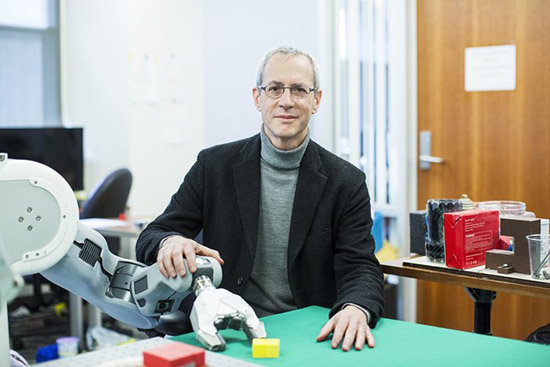连设计师的饭碗也抢,人工智能还有什么干不了?

|
卡拉威(Callaway)是全球知名的高尔夫球具生产商。对这家公司来说,制作球杆一直是一种劳动密集型工作——从杆头的打磨、抛光,到木制杆身和其它钢铁零件的制作,都需要大量人力来完成。不过长期以来,卡拉威都非常注重将手工艺术与科技创新相结合。最近,它甚至还与航空业巨头波音公司合作,推出了几款符合空气动力学原理的球杆。 四年前,卡拉威公司在建立最新的Epic Flash产品线时,更是革命性地引入了人工智能和机器学习技术。一般来说,卡拉威公司在设计一款球杆时,要制作5到7个实体原型产品。但对于Epic Flash系列产品,它却能够创造出15000个虚拟原型设计。然后,计算机算法会根据球速等指标,并参考美国高尔夫协会的相关规则,判定哪个设计方案的性能最优秀,从而确定其中的最佳设计方案。由此设计出的Epic Flash一号木杆被《高尔夫文摘》(Golf Digest)的2019年度“热门榜单”授予了20分的满分,它也是今年唯一一根获得满分殊荣的球杆。如果它的设计者是一名人类设计师的话,是不可能完成如此快速准确的产品迭代的。 现如今,由计算机算法进行的设计已经变得越来越普遍,甚至变成了一种常态,它甚至很有可能改变整个世界的面貌。设计高尔夫球杆只是它的功用之一。巴塞罗那的机器学习公司Alpha的创新总监莫里斯·康提表示:“对于我所设计的东西,如果我能对它在现实生活中的条件有精确的了解,我就可以将它设计得更好。”虽然人工智能和机器学习目前还处于萌芽阶段,但它已经让建筑行业发生了深刻变化,无论是一砖一瓦还是摩天大楼,它都能帮助设计师以前所未有的速度解决各种技术问题。 有一个例子可以反映出人工智能技术带来的深刻变化。根据联合国下设的世界知识产权组织的一份最新报告,自从2013年以来,全球已经发布了逾17万项人工智能相关专利,占该领域所有专利的50%左右。而人工智能在设计领域的应用,也像该技术在其它领域的应用一样,既令人感到兴奋,又给人以不寒而栗之感。在这方面,有很多问题是需要思考的:如果计算机算法在很大程度上已经可以完成设计任务了,人类设计师还将扮演什么角色?人类的手(和心)还重要吗?在某些时候,人工智能是否可以直接接管设计工作了?人工智能真的会产生有灵感的设计吗?还是它会冷酷地以牺牲舒适性、美感和实用性为代价,优先考虑成本效率问题呢? 在这次设计革命中处于先驱者地位的,是Adobe和Autodesk这种计算机辅助设计(CAD)公司,以及谷歌、IBM和微软等技术巨头。2016年,Adobe推出了一个名叫Adobe Sensei的程序,它本质上是一个为Adobe的“创意云”(Creative Cloud)和其它相关平台提供支持的机器学习网络。设计师们已经开始使用它的图像比对和客户数据读取等工具来打磨自己的创意理念。去年秋天,Adobe公司还推出了智能提醒(Intelligent Alerts)功能,该功能可以向用户推荐他们可能从未考虑过的相关数据作为参考,真正让用户站在了“其他设计师的肩膀上”。 Autodesk公司在20世纪八九十年代凭AutoCAD成为了设计工具自动化的先行者。2017年,Autodesk公司推出了它的第一款“创成式设计”产品——Project Dreamcatcher。设计师可以通过该软件更快地测试更多设计选项。该程序可以根据用户输入的目标、材料、成本限制、制作方法等参数生成各种方案。通用汽车公司就是该软件的早期用户之一,该公司表示,他们正在使用这些工具帮助公司制造更轻量化、更坚固的零部件。 家具、建筑和时尚等行业也在试用这些创新设计工具,并且认为它们具有改变整个行业面貌的潜力。比如家具行业就有两个有趣的例子:其一是多伦多的一家名叫Radical Norms的研究公司,该公司部署了一个谷歌研发的平台;其二则是著名设计师菲利浦·施密特和史蒂芬·韦斯,他们将从社交网络Pinterest上下载的562张20世纪的椅子的照片输入了一个神经网络,设计出来的椅子别说放在家里的阳台上,就是放在当代艺术画廊里也毫无违和感。这些案例表明,未来人工智能很可能会成为一种行业标准,可以在节省大量时间和金钱的情况下,设计出图案、样式、色彩都极其个性化的产品。 在时尚界,意大利电商平台Yoox是首批引入人工智能技术的公司之一。它的自有品牌“8 by Yoox”就是通过分析社交媒体和互联网内容,关注核心市场,评估关于市场趋势、已售产品、顾客反馈等方面的数据而打造的。该品牌的男、女装都属于并不令人惊讶的“必需品”,看起来既有时尚感,又不会显得离经叛道——这恰恰是对消费者品味综合分析的结果,而不是来自于某位艺术家的“灵光一闪”。 图形设计是机器学习正在影响的另一个领域,在这一领域处于领先地位的Tailor Brands和Logojoy等创业公司都获得了风投的有力支持。这两家公司都为小企业提供Logo、文具等物品的定制设计服务。去年,芯片设计公司英伟达发布了据称是首款采用人工智能技术制作的视频游戏演示片段。此外,目前至少还有一个人工智能团队正在探索气味设计——IBM研究院正在与香水制造商Symrise合作研发香水。 随着试用人工智能技术的设计领域越来越多,从总体上看,设计这项工作本身已经处于重大变革的边缘,变得越来越数据化、自动化和效率化。这种趋势也是有风险的:设计师不再是技术的使用者或协作者,而成了人工智能创意的保管员,这样一来,设计很可能会失去人的维度,变得越来越同质化。 另一种可能性是:同理心的重要性可能会进一步增强。人工智能专家、风投家李开复在他的著作《人工智能超级大国:中国、硅谷和世界新秩序》(A.I. Superpowers: China, Silicon Valley, and the New World Order)中指出,有两类事情是人工智能做不到的(至少现在还不能)。一是创造性的劳动,比如科学、讲故事和艺术,当然也包括设计;二是构建同理心、共情与信任——它们都需要人与人之间联系。只有人类能真正生产出有意义地服务于人类的产品。同样,对于一个服务于人类社会的城市开发计划,也只有人类设计师才能理解其复杂性。 正如有关专家在下面的采访中所说的那样,机器学习与设计的联姻才刚刚开花结果。要不了多久,由人工智能完成的设计将开始无可避免地改造我们身边的世界。随着技术不断地改变我们的职业属性,影响我们的资源配置,甚至改造着我们所工作和生活的物理环境,设计行业也和其他正在被人工智能改造的行业一样,很快将遇到一系列社会、文化和伦理问题。因此,设计师必须学会站在人的理性和感性角度,引导人工智能为人类所用,而不是让人工智能来引导他们。 莫里斯·康提 Alpha公司创新总监。Alpha是巴塞罗那的一家机器学习公司,主要关注医疗和能源领域的创新技术。 “我们最近做了一个用来评估团队合作情况的(人工智能)原型产品。我们早期的研究结果表明,人工智能在对做同样训练的团队进行观察时,其表现并不亚于一个训练有素的人类心理学家,除了两点区别:一是它是机器,所以你不需要掏钱请心理学家——它具有高度的可拓展性;二是它可以实时进行,而人类心理学家则需要观察和比对结果,然后才能对协作程度给出意见或评分。” “我认为,你可以将这些技术应用到任何行业的几乎任何一个小的方面。无论是设计风力涡轮机,还是设计一幢房子的一面墙,你都能做得更好。因为我们有了更多、更好的数据,同时对这些数据有了更深的理解。人工智能好比花生酱,它可以被抹到(很多个行业)。对于我设计的东西,如果我可以对它在生活中的使用条件有更精确的理解,我就能设计得更好。” |
At Callaway, the high-end golf-equipment stalwart, the process of making clubs has always been quite labor-intensive—from grinding and polishing clubheads to crafting wood-and-steel-shafted irons and wedges. The company has also long combined such artisanal handwork with technological innovation, even partnering with aerospace titan Boeing recently to codesign several aerodynamic clubs. So when the company set out about four years ago to make its latest club line, called Epic Flash, it took the next evolutionary technological step, turning to artificial intelligence and machine learning for help. A typical club-design process might involve five to seven physical prototypes; for Epic Flash, Callaway created 15,000 virtual ones. From those, an algorithm determined the best design, selecting for peak performance—i.e., ball speed—while also conforming to the rules set forth by the U.S. Golf Association. Golf Digest gave the $530 Epic Flash driver a score of 20 out of 20 on its 2019 “Hot List,” the only driver to earn that honor. A human could not have achieved this kind of rapid iteration, or precision. The Epic Flash offers just a taste of the ways in which algorithm-driven design could transform our planet as it becomes significantly more common and, in time, even the norm. “With a precise idea of the conditions this thing I’m designing will see in real life, I can design it better,” says Maurice Conti, chief innovation officer at Alpha, a Barcelona machine-learning firm and moonshot factory. Though still nascent, artificial intelligence and machine learning are starting to alter our built world, from spatulas to skyscrapers, ¬helping designers solve technical problems with unprecedented speed. To understand the profound shift taking place, one need only consider that, according to a new report from the UN’s World Intellectual Property Organization, more than 170,000 A.I. patents have been published worldwide since 2013, adding up to 50% of all patents in the field. And in the context of design, as with most things related to A.I., the results have the potential to be both terrifying and exhilarating. There are many questions to ponder: What will the role of the designer be when algorithms can largely design for us? Will the human hand (and heart) remain key to the process? At some point, will A.I. simply take over? Will A.I. actually produce inspired design—or will it coldly prioritize cost efficiency at the expense of comfort, aesthetic pleasure, and practicality? The pioneers of this evolution are computer-aided design (CAD) companies like Adobe and Autodesk, as well as tech giants such as Google, IBM, and Microsoft. In 2016, Adobe launched a program called Adobe Sensei, a machine-learning network that powers its Creative Cloud software and many of its other platforms. Designers who work with Adobe have started using Sensei tools like image matching and readings of customer data in order to hone their own ideas. Last fall, the company introduced Intelligent Alerts, which metaphorically peers over designers’ shoulders to recommend relevant data sets they might not otherwise have considered. Similarly, in 2017, Autodesk—the firm that kick-started the automation of design tools in the 1980s and ’90s with AutoCAD—announced its first commercial “generative design” product, Project Dreamcatcher. Designers use Dreamcatcher to test more design options more quickly: The program generates possibilities based on user inputs about objectives, materials, cost restrictions, manufacturing methods, and so on. One early Dreamcatcher use case: General Motors is developing auto parts with these tools, which it says are helping it build both lighter and stronger pieces. Trades like furniture-making, architecture, and fashion are experimenting with these new tools and considering their industry-shifting potential. Two playful furniture-making exercises using A.I.—one by Radical Norms, a Toronto research company, implementing a Google-powered platform; another by designers Philipp Schmitt and Steffen Weiss that put 562 Pinterest photos of 20th-century chairs into a neural network—have generated furniture that would look more at home in a contemporary art gallery than on your veranda. But they point toward a future when A.I. could become an industry standard, allowing for hyper-¬personalized products with body-fitting designs and customized colors and patterns while also saving significant time and money. In fashion, the Italian e-commerce platform Yoox has been among the first to introduce an A.I.-led line, the private label 8 by Yoox. The collection was created by compiling content from across social media and the Internet, focusing on key markets, and reviewing data about trends, products sold, and customer feedback. The resulting men’s and women’s collections are unsurprising “essentials” that look sort of stylish without veering toward the outré—the outcome you might expect from designs that reflect an aggregated analysis of preferences rather than an individual artist’s flair. Graphic design is another area that machine learning is affecting, with the venture-backed startups Tailor Brands and Logojoy at the forefront, both of them offering services that automate the making of logos, stationery, and the like for small businesses. Last year, chip designer Nvidia unveiled what it claims is the first-ever video game demo with A.I.-generated graphics. And at least one A.I. team is exploring scent design: Partnering with fragrance-maker Symrise, IBM Research recently developed perfumes using machine learning. As the disparate list of experiments grows longer, design in general is on the precipice of a major morph, becoming far more data-¬driven, automated, and efficient. The risk is that design could become homogenized and lose its human dimension as designers become custodians of A.I.-driven ideas rather than users of the technology as a collaborator and tool. There’s an alternative scenario: The importance of empathy might actually grow. As A.I. expert and venture capitalist Kai-Fu Lee points out in his book A.I. Superpowers: China, Silicon Valley, and the New World Order, there are two categories of things A.I. can’t do (at least not yet). One is carry out creative endeavors, like science, storytelling, art, and, yes, design; the other is build empathy, compassion, and trust—all of which require human-to-human connection. Only humans can truly make a product that meaningfully serves its customer. The same goes for understanding the complexities of an urban plan that serves its community. As A.I. experts tell Fortune in the interviews that follow, the link between machine learning and design is just beginning to bear fruit. Soon enough, A.I.-led design will be an unavoidable shaper of the world around us. And it’s a certainty that design, like other industries being altered by A.I., is soon to face a host of social, cultural, and ethical dilemmas as technology changes job descriptions, reallocates resources, and changes the physical environments where we live and work. It’s all the more important, then, that designers learn how to thoughtfully and compassionately steer A.I. rather than let A.I. steer them. Maurice Conti Chief innovation officer, Alpha, a Barcelona machine-learning firm focusing on creating technologies that could reshape fields like health and energy. “We recently built [an A.I.] prototype to assess teamwork and collaboration. Our early results show that A.I. can perform at the same level as a trained human psychologist observing a team doing the same exercises, except (A) they’re machine systems so you don’t need the psychologist—it’s super scalable; and (B) we can do it in real time, whereas a psychologist has to observe and collate results, and give an opinion or rating on collaboration. “I think you can apply these technologies to just about every small facet of any industry. You’ll get better at designing things like wind turbines or building curtain walls for buildings because we’ll have more data—better data—and a better understanding of that data. A.I. is sort of a peanut butter you can spread across [multiple industries]. With a precise idea of the conditions this thing I’m designing will see in real life, I can design it better.” |

|
拉娜·埃尔·卡利欧比 Affectiva公司联合创始人及首席执行官。Affectiva是一家获风投支持的公司,它的“情感AI”已经被汽车、教育、医疗等行业的部分企业采用。 “我并不认为机器人会掌管这个世界,不过我更担心一些迫在眉睫的威胁,比如围绕人工智能存在的偏见,也担心人们不能理解这些技术应该如何部署和使用。我们非常支持人工智能的发展。” “在人工智能领域,我们主要关注面部识别技术。如果你主要使用白人的脸去训练面部探测器,那么如果你去非洲或亚洲的话,可能就行不通了。我的老家在埃及。所以我想:‘我们需要把戴头巾的女性也放入数据集!’” “我们喜欢把它当作这种先进技术交互的一个体现。我们也可以把它带到家里或办公室里。去年秋天,Affectiva与软银机器人公司达成合作,共同研发社交机器人。我们将在机器人的情感和社会性大脑的构建上处于领先地位。” 马克·尼茨伯格 加州大学伯克利分校人类兼容人工智能中心(CHAI)常务主任,寒武纪集团(Cambrian Group)负责人兼首席科学家。寒武纪集团主要与通用电气和宝马等公司就规划、战略和设计等方面开展合作。 “CHAI的使命,是以一种安全的、可以兼容人类的目标和偏好的方式彻底改造人工智能。自从有工艺这种东西开始,一个系统之所以被构建出来,就是为了实现它的目标。随着我们打造了越来越多的这种系统,它们虽然能够实现目标,代价却是牺牲了我们的偏好。比如,当我们经过一个机器人时,我们的偏好是不让我们的手臂被扯下来。你可能认为这是一个明显的偏好,但并非流水线上的每台机器人都写入了这个程序。这就是为什么很多机器人都是在笼子里作业的。” “人工智能可能的确有某种智能存在,但它并非人类智能的机器版本。如果你问斯图尔特·拉塞尔(CHAI里的一名研究人员):‘你能在机器里创造意识吗?’就算你给他50亿美元,他也不知道怎样才能做到。我想人工智能界的大多数人也会给出同样的答案。”(财富中文网) 本文的另一版本登载于2019年3月刊的《财富》杂志,题目为《数据重造》。 译者:朴成奎 |
Rana el Kaliouby Cofounder and CEO, Affectiva, a venture-backed company whose pioneering “Emotion A.I.” is used by brands in the auto industry, education, and health care. “I don’t see a world in which the robots are going to take over. I really worry about the more imminent threats of A.I. around bias, though, and not understanding how these technologies are going to get deployed and used. We’re very big advocates of that [broad perspective]. “In A.I., we deal with facial recognition. If you train the face detector with mostly faces of, I don’t know, white men, and then you go to Africa or Asia, it’s not going to work. I’m originally from Egypt—I’m like, ‘We need women who are wearing hijabs to be in the data set!’ “We like to think of the vehicle as an example of what this advanced interaction with technology will look like. We can also take that into the home or the office. Last fall, [Affectiva] announced a partnership with SoftBank Robotics to make social robots. We’re going to be in the lead on the emotion and social brain of the robot.” Mark Nitzberg Executive director, Center for Human-Compatible A.I. (CHAI) at UC Berkeley, and principal and chief scientist, Cambrian Group, which works with companies like GE and BMW on planning, strategy, and design. “[CHAI’s] mission is to reinvent A.I. in a way that’s safe and compatible with human objectives and preferences. Since the beginning of engineering, a system would be built to achieve the objectives of that system. As we delegate more and more to such systems, they achieve their objectives at the expense of our preferences. For example, our preference is not to have our arm ripped off when we walk by a robot. You would think it’s an obvious preference, but it’s not programmed into every robot on the assembly line. That’s why many are in cages. “There may be some kind of intelligence in A.I., but it’s not a mechanical copy of human intelligence. If you asked [CHAI faculty member] Stuart Russell, ‘Will you create consciousness in a machine?’—you couldn’t give him $5 billion to do that. He does not know how to do that, and I think most of the A.I. community would say the same.” A version of this article appears in the March 2019 issue of Fortune with the headline “Remade By Data.” |













